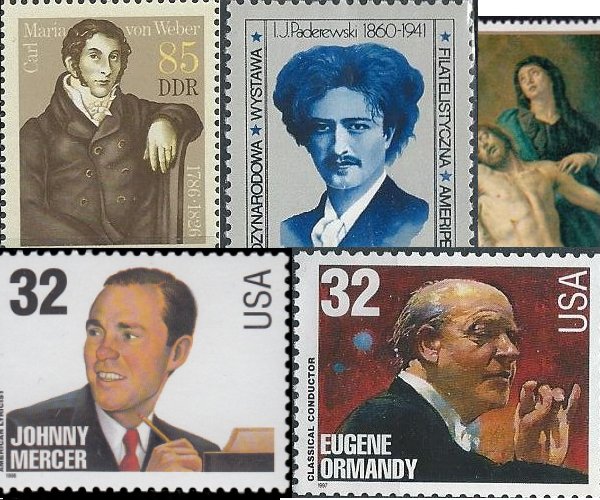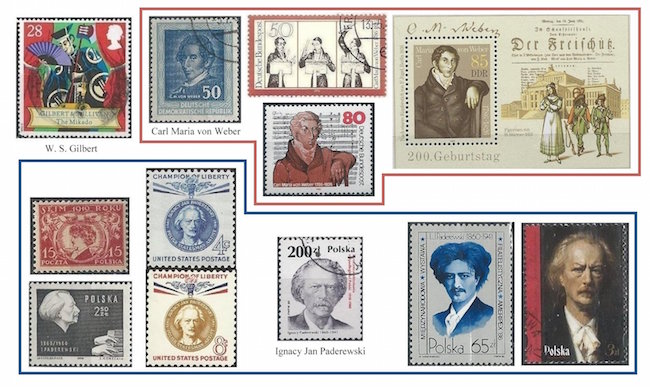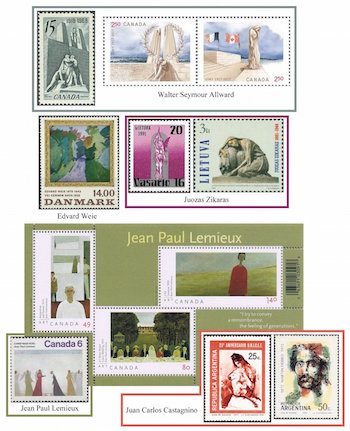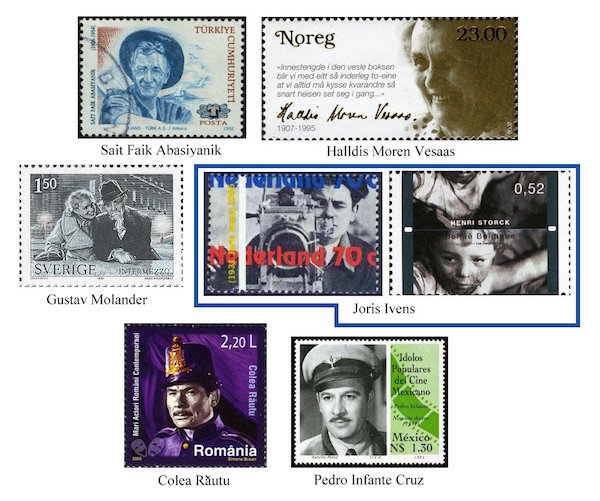The Arts on Stamps of the World — November 18
An Arts Fuse regular feature: the arts on stamps of the world.

By Doug Briscoe
Well, this is just nuts. Of course, the year isn’t over yet, but I think it highly unlikely we’ll see another day to equal November 18 in terms of the sheer number of artists (with stamps!) associated with it (birthdays, mostly). Not to keep you in suspense, there are twenty-eight. Yes, twenty-eight. Biological blurbs will of necessity be extremely brief. Apologies if your favorite gets short shrift.
The four headliners are all associated with music: W.S. Gilbert, the writer half of Gilbert and Sullivan, German composer Carl Maria von Weber, Polish pianist and statesman Ignacy Jan Paderewski, and Philadelphia Orchestra conductor Eugene Ormandy. That being the case, and with the unholy number of subjects today, I think I’ll depart from my usual practice and group them together in manageable clumps by topic.

MUSIC, 1st collage:
Sir William Schwenck Gilbert (18 November 1836 – 29 May 1911) does not actually have his own stamp but shares the glory with partner Sir Arthur Sullivan in a set of five stamps recalling favorite G&S operettas. I picked Mikado for your viewing pleasure.
Well, Carl Maria von Weber (1786–1826) may have been born on the 19th, I guess. He was born in Holstein, though his family had come from southern Germany. He was not of the nobility—his father had adopted the “von” to give himself airs—but he belongs firmly among the nobility of composers, and not only because, four years before Carl was born, his cousin Constanze Weber had married Mozart: Weber’s own efforts assure him a place in the pantheon. (I enjoy his Bassoon Concerto more than I do Mozart’s, which is not necessarily to say that I think it’s a better piece.) He was a seminal composer of German Romantic opera, and Debussy gave him the compliment of saying that his orchestration was achieved through “the scrutiny of the soul of each instrument.” All his stamps come from the two Germanies.
Say “Paderefski” not “Paderooski”! Ignacy Jan Paderewski (18 November [O.S. 6 November] 1860 – 29 June 1941) is revered in his native Poland more as a statesman, I suppose, than as a musician, and it is in that regard that he has usually been celebrated on stamps. Thus his first stamp (the small red one) dates from 1919, when he was a member of the First National Assembly, and even the US honored him in his centenary year as a “Champion of Liberty”. Paderewski was also a fine composer, and I remember reading that of all his many significant accomplishments, composing had given him the most satisfaction.
MUSIC, 2nd collage:
Hungarian-American conductor Eugene Ormandy (1899 – March 12, 1985) was born Jenő Blau to Jewish parents in Budapest. He played violin publicly from the age of seven and was graduated from the Hungarian Academy of Music with a master’s degree at 14. He also earned a degree in philosophy before coming to the US in 1921. From 1936 he took on the role most associated with him: conductor of the Philadelphia Orchestra, where he reigned for 44 years.
Four Hispanic composers also share this birthday, two Spanish and two Cuban.
Félix López Crespo (1742–1821) was an organist and composer who served at the Capilla Real de Madrid, slowly working his way up from fourth organist (1775) to first (1805). Apart from organ and harpsichord/piano music, López wrote an opera El disparate and some villancicos.
Also from Spain, Amadeo Vives (1871 – 2 December 1932) composed over a hundred zarzuelas, the most famous being Doña Francisquita (1923). Isaac Albéniz believed that Vives could have been a major international figure if he had pursued his symphonic ambitions and written in a more universal style, but Vives seems to have been a rather nervous individual who lacked self-confidence. He died in Madrid, where he had lived for most of his life.

César Perez Sentenat (1896–1973) was a Cuban pianist and composer. He studied at the Schola Cantorum in Paris under Moritz Moszkowski. Together with Gonzalo Roig and Ernesto Lecuona he founded the Havana Symphony Orchestra. Sentenat’s compositional output consists in piano pieces and songs, but he was also an important teacher, Horacio Gutiérrez being among his students.
The Cuban musician known as Compay Segundo (18 November 1907 – 13 July 2003) was born Máximo Francisco Repilado Muñoz Telles. He came to be known as “Segundo” because he was always the second voice, notably in the highly successful duo Los Compadres, a partnership with Lorenzo Hierrezuelo that they started in 1947. Segundo’s most famous song is “Chan Chan“.
Armenian composer Spiridon Melikyan (1880 – May 4, 1933) studied with Komitas at the Gevorgian (sic, not “Georgian”) Seminary, from which he was graduated in 1902. After further study in Berlin he became himself a teacher and went on to found the Tbilisi Armenian Musical Society in 1912 and the Armenian Choral Society in 1917. He wrote a children’s opera, Brother-Lamb (1914), folk song arrangements, and other works, as well as writing a number of musicological essays and at least one book on the history of music (1935).
Polish soprano and mezzo-soprano Wanda Wermińska (1900 – 30 August 1988), born actually in Ukraine, encompassed a wide repertoire ranging from Mozart, Beethoven, and Bizet to Verdi, Wagner, and Smetana. She left Poland in 1929 and performed widely, living and singing in South America during the Second World War under such conductors as Bruno Walter, Fritz Busch, and Wilhelm Furtwängler and with star singers including Kirsten Flagstad, Beniamino Gigli, Lily Pons, and Mario del Monaco. She returned to Poland in 1947.
Japanese guitarist and composer Masao Koga (November 18, 1904 – July 25, 1978) was a key developer of the modern popular genre called enka, a sort of Japanese version of the blues. Koga himself preferred the more generic term ryūkōka. This style he embodied in the 1930s and 40s. His compositions have been featured in a number of films, including Come See the Paradise (1990) and Memoirs of a Geisha (2005).

Tin Pan Alley lyricist Johnny Mercer (November 18, 1909 – June 25, 1976) also wrote the music for a few songs, but mostly he collaborated with composers such as Harold Arlen (“That Old Black Magic”, 1942), Hoagy Carmichael (birthday next Wednesday), Henry Mancini (“Moon River”, 1961), Jerome Kern, and many more. Among the other hits were “Jeepers, Creepers!” (1938), “Fools Rush In” (1940), and “The Glow-Worm” (1952). Mercer was also the founder of Capitol Records in 1942.
VISUAL ARTS, 1st collage:
Flemish painter Gaspar de Crayer (18 November 1584 – 27 January 1669) of Antwerp was court painter to the Spanish governors of the Netherlands. He is represented on an Easter stamp from the Cook Islands showing his Descent from the Cross. De Crayer painted many religious altarpieces as well as portraits.
Another religious artist, but one from a later century and from halfway around the world, was the Brazilian sculptor and architect Antônio Francisco Lisboa, known as
Aleijadinho, who was born in colonial Brazil in either 1730 or 1738 and died on this date in 1814 (that is, assuming he ever existed—apparently there is some doubt about that). “Aleijadinho” means “little cripple”, as it seems he may have suffered from leprosy. It is said that as the disease worsened he continued working by having hammer and chisel strapped to his fingerless hands. The stamp shows one of the external pieces of statuary attributed to him. There are also richly painted interior figures.
Far from Aleijadinho both in geography and subject matter was the Swedish painter of genre pictures Pehr Hilleström (18 November 1732 – 13 August 1816). He also painted scenes of craftsmen at work, as exemplified by In the Anchor-Forge at Söderfors (1782). Hilleström also became a master tapestry weaver and was director of the Royal Swedish Academy of Arts from 1810.
Mathurin Moreau (18 November 1822 – 14 February 1912) was a French sculptor, born at Dijon. One of his more celebrated works is the allegorical statue of Oceania (Océanie) that he created for the Universal Exposition of 1878 and that now sits in the courtyard of the Musée d’Orsay. The museum is honored on a set of stamps from São Tomé.
The Czech painter Mikoláš Aleš (18 November 1852 – 10 July 1913), besides possessing the reputation of being one of his country’s finest artists, was a hugely prolific illustrator credited with over 5,000 published pictures. Magazines, textbooks, even playing cards bear his imprint. Besides his many murals, he is known for his work for the foyer of the Prague National Theater. After the stamp depicting Aleš himself, there is a pair showing illustrations he made for the works of author Alois Jirásek, then another pair depicting Hussite leader Matìj Louda and the Legend of the Dragon of Trutnov. The two more recent stamp issues offer Messenger of Mourning and St. Wenceslas (window, 1890), the latter for the sesquicentennial of Aleš’s birth in 2002.
VISUAL ARTS, 2nd collage:
Walter Seymour Allward (1876 – 24 April 1955) was possibly the foremost Canadian sculptor of public monuments in the early 20th century. One of his most noteworthy efforts was the National Vimy Memorial, a work some fifteen years in the making (1921-36). It has twice been represented on stamps of Canada, first in 1968 and again in 2016, near the 50th and 100th anniversaries of the Battle of Vimy Ridge.

Danish painter Edvard Weie (18 November 1879 – 9 April 1943), born in Copenhagen, was a highly self-critical modernist and later abstract artist. Apart from his canvases, he left a volume of his thoughts on art, Poetry and Culture (publ. 1951). The stamp offers us A Road Through a Wood (1932).
One of the first professional sculptors from Lithuania was Juozas Zikaras (November 18, 1881 – November 10, 1944). His most significant work was done during the period of Lithuanian independence between the wars. His version of the Lithuanian coat of arms was used for the republic’s early coinage, and his monumental Statue of Liberty (1922) in Kaunas was used for one of the first stamps to appear when the country regained its independence after the fall of Communism. A more recent stamp offers his Sadness (Liūdesys). The NKVD suspected Zikaras’s sons of being members of the anti-Soviet partisan group the Forest Brothers and interrogated him, whereupon Zikaras took his own life. One of those sons, Teisutis Zikaras, emigrated to Australia after the war and also became a sculptor.
Again we have a visual artist whose reputation exceeds that of most of his peers, in this case, painters of 20th-century Québec. Jean Paul Lemieux (18 November 1904 – 7 December 1990) studied in Montreal, where one of his teachers was Edwin Holgate, and in Paris before himself taking up teaching. He taught for thirty years, mostly in his native Québec. His Nativity was chosen for a 1974 Canadian Christmas stamp, and in 2004 a small sheet was issued for his centennial, containing the paintings Self-portrait (1974), June Wedding (1972), and Summer (1959).
Juan Carlos Castagnino (November 18, 1908 – April 21, 1972) was an Argentine painter who also left many drawings. He first exhibited in 1933, subsequently expanding his studies in Paris under André Lhote. On his return to Argentina in 1941 he went back to school and earned a degree in architecture. For a 1972 UNICEF stamp, Castagnino’s Mother and Child was selected for the design. A later stamp shows one of the artist’s illustrations for the epic poem Martín Fierro by José Hernández.
LITERATURE and FILM:
Sait Faik Abasiyanik (18 November 1906 – 11 May 1954), who usually published under the name Sait Faik, is cited as one of the greatest writers of short stories from Turkey. His first collection, The Tea Urn (Semaver), came out in 1936, and the succeeding eighteen years saw a further ten volumes of stories, two novels, and one book of poetry.

Norwegian writer Halldis Moren Vesaas (18 November 1907 – 8 September 1995) was mostly active in the 1930s and 40s. Her first publication was a volume of poetry, Harp and Dagger (Harpe og dolk, 1929). Two more books of poems appeared before she married fellow author Tarjei Vesaas (1897-1970) in 1934 and then began writing children’s books. The year 1955 saw her last book of poems until she came out with another forty years later in 1995, the year she died. Vesaas had continued writing during this long period, essays, articles, reviews, and other short pieces, and she also translated for the stage: Molière, Racine, Brecht, Rostand.
The parents of Swedish actor, film director, and screenwriter Gustav Molander (18 November 1888 – 19 June 1973) were themselves a stage director and an actress. Molander’s brother and one of his sons also went into directing, another son into acting. He attended, and later led the Royal Dramatic Theater in Stockholm, one of his students being Greta Garbo. Molander directed 62 films from 1923 to 1956 and came out of retirement to contribute to the anthology film Stimulantia in 1967. He also wrote screenplays for Victor Sjöström and Mauritz Stiller. His most renowned film may be the original Swedish version of Intermezzo (1936), starring Ingrid Bergman and Gösta Ekman. Three years later, Bergman would star in the Hollywood remake. The Swedish stamp shows a still from the 1936 version.
Dutch documentary filmmaker Joris Ivens (18 November 1898 – 28 June 1989) made his first motion picture at the age of 13. He worked for two years on a ten-minute short called Rain (1929). He was invited to the Soviet Union to make a documentary with music by Hanns Eisler. With co-director Henri Storck Ivens made Misère au Borinage in 1933-34. Ivens lived in the US from 1936 to 1945, but made The Spanish Earth in support of the republican effort in the Spanish Civil War; this film was co-written by Ernest Hemingway and had music by Marc Blitzstein and Virgil Thomson. For a documentary on China, The 400 Million (1939), he worked with Robert Capa (camera), Sidney Lumet (reader), Eisler again for the music, and Fredric March (narration). As a staunch leftist, he was driven out of the United States after the war but was allowed to return to visit his sick friend Paul Robeson. After the 1970s Ivens slowed down, but still produced two more films, one of them the year before his death. While the Dutch stamp honors Ivens, the Belgian one is for Storck, but shows a still from their collaborative Misère au Borinage.
Romanian thespian Colea Răutu (18 November 1912 – 13 May 2008) acted on the stage and sang with the Cluj Opera Chorus before making his first film in 1954. Later he further diversified into TV. He lived to be 95.
We finish up with a centenary. Today is the 100th anniversary of the birth of Mexican actor Pedro Infante (18 November 1917 – 15 April 1957), who is beloved by Latin American audiences. He, Jorge Negrete, and Javier Solís were known collectively as the Tres Gallos Mexicanos (the Three Mexican Roosters). Besides acting in about sixty films from 1939, he was a singer who recorded some 350 songs, beginning in 1943. In Sobre las Olas (Over the Waves, 1950), he portrayed the Mexican waltz composer Juventino Rosas. Infante dearly loved flying and was killed in an air crash while piloting a converted B-24 at the age of 39. Fifty years after his death his shrine still draws legions of fans.
Gee, I wish Wyndham Lewis (18 November 1882 – 7 March 1957) had a stamp, too, so I could do a little more work today. He was an English writer, painter, and critic. Canadian novelist and poet Margaret Atwood (born November 18, 1939) is on the short list, I daresay.
A graduate of the University of Massachusetts with a B.A. in English, Doug Briscoe worked in Boston classical music radio, at WCRB, WGBH, and WBUR, for about 25 years, beginning in 1977. He has the curious distinction of having succeeded Robert J. Lurtsema twice, first as host of WGBH’s weekday morning classical music program in 1993, then as host of the weekend program when Robert J.’s health failed in 2000. Doug also wrote liner notes for several of the late Gunther Schuller’s GM Recordings releases as well as program notes for the Boston Classical Orchestra. For the past few years he’s been posting a Facebook “blog” of classical music on stamps of the world, which has now been expanded to encompass all the arts for The Arts Fuse.
